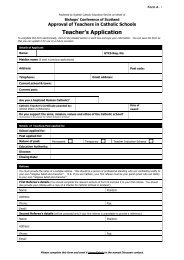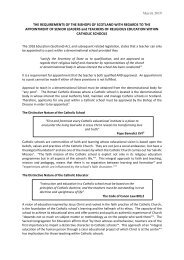You also want an ePaper? Increase the reach of your titles
YUMPU automatically turns print PDFs into web optimized ePapers that Google loves.
Founded in 2011, Zappar have been trailblazing and setting best practice in the AR<br />
space for nearly a decade. They are a creative business and an augmented reality<br />
software platform, rolled into one. ZapWorks is an award-winning suite of tools<br />
for creating AR experiences, built for designers and developers. Zappar’s in-house<br />
team use these tools to produce AR content for some of the world’s biggest brands.<br />
Illustrations by Anna Broadhurst
With thanks to our<br />
Contributors<br />
Jeremy Dalton | Head of VR/AR, PwC<br />
Dan Ferguson | Co-founder / EVP of Digital and XR<br />
Strategy, Groove Jones<br />
Alex Dodkin | Founder / Digital Strategy, Eggplant Digital<br />
Nathaniel Hulley | Technical Lead, VCCP CX<br />
Frans Tihveräinen | CEO /AR Designer, flyAR<br />
Eero Salminen | Chief Technology Officer, flyAR<br />
Riaan Nel | Director, Sky Digital SA
01 What is WebAR<br />
| Zappar’s WebAR Journey<br />
02 Market Perspectives<br />
| PwC<br />
| Groove Jones<br />
| Eggplant Digital<br />
| VCCP<br />
| flyAR<br />
| Sky Digital SA<br />
03 WebAR vs...<br />
04 How to deliver WebAR<br />
05 Product Considerations<br />
| Instant Tracking<br />
| File Saving/Sharing<br />
| The Toolbar<br />
| Permissions<br />
| Analytics<br />
| Cookies
06 Zappar’s QR Code Best Practice<br />
| Rules<br />
| Size<br />
| Your CTA<br />
| 5 C’s for Success<br />
07 Summary<br />
WebAR Examples<br />
Getting Started Guide<br />
| Tracking Types<br />
| Publishing<br />
| Custom Branded WebAR<br />
| Resources
The introduction of WebAR (augmented reality made accessible through the<br />
mobile browser) with Zappar in 2019, was another important milestone for an<br />
industry still in its infancy that has begun to find its feet over the last decade as<br />
more businesses look to define their camera strategy. As with native apps back<br />
in 2010, there’s both excitement about the potential but also confusion about<br />
the possibilities that WebAR offers. This guide has been written to give brands<br />
and agencies practical advice surrounding the benefits and opportunities of<br />
WebAR but also highlight the current limitations and pitfalls of the tech in the<br />
short term.<br />
At Zappar we’ve had the privilege to work with hundreds of brands across the<br />
world delivering thousands of AR experiences for a multitude of use cases<br />
spanning retail, connected packaging, learning & development, entertainment,<br />
sports marketing, tours & events, product visualization, remote assistance, new<br />
product development, enterprise sales and more. As with all things in life there’s<br />
no substitute for learning through doing and practical application to understand<br />
what works and more importantly, what doesn’t. This guide is designed to not<br />
only to give you a thorough grounding in the current capabilities of WebAR but<br />
to also showcase some of these use cases.<br />
The reach and accessibility that WebAR delivers opens up many new possibilities<br />
for brands and businesses who were excited about the notion of AR but had<br />
concerns surrounding app downloads. But as with all things technical, the fact<br />
that WebAR is possible is not a good enough reason to execute unless the<br />
experience delivers a genuine end user benefit. That requires greater thought<br />
as AR matures into a facilitating technology as part of an always-on mobile<br />
strategy with more practical everyday utility that needs to be robust, scalable<br />
and effective.
Our mission has always been to democratise AR for the mass market to deliver<br />
value for brands, businesses and end-users alike. WebAR is another step on<br />
that journey. We hope this guide gives you a holistic overview of WebAR and<br />
provides the insights and tools to help you better execute against your given<br />
objectives across your organisation.<br />
What we know from experience is that the AR landscape, especially as it pertains<br />
to WebAR, will continue to evolve and improve at pace. The current capabilities<br />
and case studies already show the effectiveness of this new canvas to drive<br />
engagement, user interaction, sales success and better analytics. For all the talk<br />
of future technologies and possibilities, the opportunity exists now through<br />
WebAR if executed properly.<br />
Caspar Thykier, Co-Founder and<br />
CEO at Zappar
01<br />
What is WebAR ?<br />
Simply, WebAR refers to augmented reality that can be accessed from a web browser,<br />
rather than a native app, enabling a much more seamless user journey from scan to<br />
experience.<br />
Frictionless AR<br />
As one of the newest developments in augmented<br />
reality (AR), WebAR allows immersive content to be<br />
delivered straight to the user's smartphone without<br />
the need to stop and download an app. Scan a QR<br />
code or tap on a web link, and start interacting with<br />
the virtual world.<br />
Removing the need to search for and download an<br />
app reduces the number of steps a user has to take<br />
between awareness and experience. Fundamentally,<br />
WebAR means less friction and more effective AR<br />
experiences, customers can simply enjoy the in-themoment<br />
experience.<br />
By 2025, 72%<br />
of all internet<br />
users will solely<br />
use smartphones<br />
to access the web.<br />
(CNBC / WARC)<br />
Unmatched Reach<br />
The current number<br />
of smartphone users<br />
in the world today is<br />
3.5 billion, up<br />
from 2.5 billion from<br />
2016. (Statista)<br />
Compared to traditional AR campaigns with<br />
native apps or social media platforms, for<br />
example, WebAR offers unmatched reach<br />
and scale. With 3.5 billion smartphone users<br />
worldwide, the distribution opportunity alone has<br />
been enough to turn brands' heads as they look<br />
to free themselves from apps and platforms and<br />
imagine more seamless executions across the<br />
mobile web.
02<br />
Market Perspectives<br />
We have not been on our WebAR journey alone, here at Zappar we have the<br />
pleasure of working with companies from a variety of industries in different parts of<br />
the world to bring augmented reality to life through the web browser. Their different<br />
market perspectives provide significant insight into a new and growing technology.
How WebAR has impacted the rate at which businesses (and wider society) are<br />
adopting AR<br />
WebAR has undoubtedly increased the adoption of augmented reality. For any<br />
technology to be widely adopted, it needs to be frictionless. Prior to WebAR, if<br />
users wanted to experience augmented reality on their smartphone, they needed<br />
to install an application. With users already drowning in apps, this is an immediate<br />
disincentive.<br />
In an age where we are trying to reduce the number of clicks on a website to<br />
motivate users to take an action, why would we expect them to go through the far<br />
lengthier process of finding and installing a dedicated mobile application?<br />
How has it affected the use of AR<br />
We saw a spike in interest once clients realised that an app was no longer a<br />
prerequisite to experiencing augmented reality. Most people are wired to associate<br />
any functionality beyond browsing the web with a mobile app. For them to see the<br />
richness of an AR experience made possible through their mobile web browser is an<br />
eye-opening and awe-inspiring experience.<br />
What opportunities and use cases are there for WebAR in the next 12 months<br />
WebAR has been used a lot as a sales and marketing tool but I see a lot of potential<br />
in business to enhance communications, data visualisation, and ultimately corporate<br />
reporting. We explored only the surface of this in our Seeing is Believing report<br />
which uses WebAR to deliver engaging messages to readers and helps them visualise<br />
the global economic impact of both VR and AR technologies as a whole. I look<br />
forward to taking WebAR even further in the future!<br />
Jeremy Dalton<br />
PwC’s Head of VR/AR
Watch Now >><br />
PwC<br />
Technology is evolving at breakneck speed and is already defining what’s next — for<br />
your company, competitors, and industry. The Essential Eight technologies—artificial<br />
intelligence, augmented reality, blockchain, drones, IoT, robotics, virtual reality, and<br />
3-D printing—matter most for business today. The convergence of these individual<br />
technologies is unlocking the next wave of innovation, yielding new business solutions<br />
that are greater than the sum of their parts. We help businesses in every sector leverage<br />
this convergence of emerging technologies to multiply their capacity to work better,<br />
smarter and more seamlessly through technology. PwC’s professional services cover such<br />
areas as virtual reality soft skills training, job simulation training, collaborative augmented<br />
reality and remote assist/job aids.<br />
PwC’s accounting practice originated in London well over a century ago. As times<br />
changed and PwC expanded worldwide, our commitment to clients—like you—never<br />
wavered. With us, you’re supported by a global network of over 276,000 people in 157<br />
countries with one goal: to help your business thrive. Let’s combine your aspirations with<br />
our leading capabilities to achieve your goals.
The state of AR in the market and the current use of WebAR<br />
AR has been around for a long time. Nearly a decade ago I helped LEGO with an<br />
AR production when they were launching the Ninjago product line. It was an EXE<br />
application running on a PC connected to a web camera. Back then it was able to<br />
track your face and turn you into a Ninjago minifiger. However, performance was<br />
terrible as it was getting 5-10 frames per second. It looked like one of those stop<br />
motion animations. Revolutionary at the time but looks ridiculous compared to what<br />
we can do today.<br />
With WebAR, we are able to seamlessly connect a user to a robust AR experience<br />
today without the need of an App. Delivering a robust experience via a web browser<br />
removes any barriers. When we tell our clients about what can be done without an<br />
App they are usually blown away.<br />
Current use cases<br />
We work with big brands and their agencies to create AR experiences for marketing<br />
campaigns. From product visualization at the store shelf to creating socially shareable<br />
moments. The possibilities are endless.<br />
Storytelling - The experience we created for Modelo is a great example of a<br />
surprise and delight moment. People were so blown away by what they saw, it<br />
actually became a destination for people to visit in New York and Miami during the<br />
Halloween season. Case Study >><br />
Sweepstakes Scavenger Hunt - We created a scavenger hunt game for Corona for<br />
the chance to win a pair of custom-made sneakers. People stepped into an AR Portal<br />
that allowed them to walk out onto the iconic Corona beach and if you found the<br />
box of sneakers, you could enter a sweepstakes to win them. Case Study >>
Game for Fan Engagement and Social Good – We’ve been using AR with the<br />
Dallas Mavericks NBA team for multiple seasons. This year we created a mural<br />
that people could scan and activate a 1 on 1 game with Kristaps Porzingis. Fans<br />
got the opportunity to shoot on a virtual basketball hoop, all while trying to avoid<br />
being blocked by Porzingis. $500 was donated for each blocked shot to the Mavs<br />
Foundation, which was then to be distributed to local organizations to help stop<br />
hunger in North Texas. Case Study >><br />
Product Visualization with Interactive Hot Spots – We are doing numerous AR<br />
product visualization programs. AR allows you to not only display what is in a box,<br />
but to also display what is inside the product. Being able to show animations and<br />
give the user the ability to tap and activate additional content is really compelling.<br />
For Callaway we did this for their Mavrik golf club line to show how AI was used to<br />
create their new Drivers and Irons. The experience is running in 1,200 retail stores<br />
right now. Case Study >><br />
Watch-outs for WebAR<br />
We love that WebAR allows us to easily deploy a program via any device – iOS or<br />
Android with one single build. We want to efficiently deliver a robust experience. But<br />
we are always conscious of file size. So we always ask our client’s about where the<br />
user will be engaging with the content. If it is in a store, there may be a poor internet<br />
connection, so file size is important. We tend to focus on trying to keep our content<br />
payload under 10MBs to ensure a fast download and display.<br />
We do a lot of programs that leverage image recognition, especially outdoors for<br />
large murals and OOH displays. So we review where the ad units are being placed<br />
to ensure the camera can view the entire image. We are also conscious about the<br />
lighting conditions as that will affect the experience.<br />
What’s next?<br />
Low Touch and No Touch experiences are the new norm. WebAR allows you to<br />
engage in an experience without touching it or even being there.<br />
With the idea of in person conferences apparently on hold, we see the use of<br />
WebAR as a great way for people to engage and interact with a product demo<br />
than before. We are implementing tactics that will allow a presenter to give their<br />
audience a way to interact with a product without being there in person. On a video<br />
conference call, you can see people react immediately when they activate your<br />
content themselves. It is really rewarding.<br />
Dan Ferguson<br />
Co-founder / EVP of Digital and<br />
XR Strategy at Groove Jones
Watch Now >><br />
Watch Now >><br />
Groove Jones<br />
Groove Jones is an award-winning creative and technology studio that specializes in developing<br />
immersive Augmented Reality applications for brands. The team has a proven track record of delivering<br />
amazing digital experiences for a client roster that includes AT&T, Comcast, FX, Ford, Intel, Lexus,<br />
MasterCard, McDonald’s, Samsung, and Toyota.<br />
For more information visit - https://www.groovejones.com/
WebAR In China. Is there interest?<br />
The appeal of WebAR in China may come from the ease of just scanning a QR<br />
code – coupled with the omnipresence of WeChat and using that as a platform for<br />
launching WebAR pages. Opening up a website while you shop and finding new<br />
experiences that way is much easier than downloading an app.<br />
What WebAR is happening in China?<br />
AR use in China has largely focused on retail, entertainment, and tourism. When<br />
most people think of AR, they probably think of games like Pokemon GO. In China,<br />
consumer giants Tencent and Alibaba launched ‘Red Packet’ games through their<br />
platforms where people could scan physical objects with their cameras to find digital<br />
financial prizes.<br />
Since then, AR has been used to help market brands and integrate new experiences<br />
into consumers’ experiences. Many retail outlets, for example, created games that<br />
encouraged consumers to engage with their brand through offers of rewards.<br />
Shoppers could ‘try on’ clothes, influencers could superimpose their faces into new<br />
destinations.<br />
For tourism, Chinese tourist sites have been using AR to place old buildings or relics<br />
into the users’ viewpoints, recreating history in front of their eyes. And while zoos<br />
and other tourist sites see a lot of VR additions, AR has crept in as well, with some<br />
sites allowing children to augment their experiences with bats, for instance, showing<br />
them how the animals ‘see’ with sound.
How Is Tech reacting to WebAR needs in China?<br />
One of the benefits of using an app-based AR platform is the ability to create a<br />
higher fidelity, more interactive environment for consumers. And while WebAR<br />
in China has capitalised on brief, more limited, one-time marketing campaigns or<br />
experiences, the constant development of the technology sees WebAR becoming<br />
more and more sophisticated.<br />
And, with the advent of 5G, web AR in China could boom even further. Many of<br />
the limitations surrounding the use of WebAR – limited depth perception, lag time,<br />
environment analysis – are being solved as we speak, and with the ability to use<br />
5G network speeds (instead of potentially unreliable wifi), could drastically improve<br />
the experience on users’ phones.<br />
Is there an obvious next step?<br />
As the technology improves, the ability for brands to use WeChat as the platform<br />
for WebAR increases as well. In a country where nearly everything is done via one<br />
app – WeChat – being able to keep consumers within that environment and also<br />
experiencing a new AR could be ground breaking. All the factors for quick adoption<br />
and accelerated development are ripe in China, so watch this space!<br />
Alex Dodkin<br />
Founder / Digital Strategy<br />
Eggplant Digital<br />
Eggplant Digital<br />
Eggplant Digital create mobile and web strategies to accelerate growth in China. With China’s digital<br />
landscape shifting faster than any other market and leading the way in many social, e-commerce and<br />
mobile experiences. We make it our business to understand the changes and embrace them for our<br />
customers. Find out more - https://eggplantdigital.cn/could-webar-be-a-new-tool-for-you-in-china/
Creative agency perspective and the opportunities of WebAR<br />
At VCCP CX we specialise in creating dynamic design-led experiences, that allow<br />
brands to reach their customer audiences in fun and engaging ways. Six months ago<br />
VCCP CX launched the easyJet Randomiser AR experience on Instagram, allowing<br />
users to get personalised holiday recommendations, and the ability to share them<br />
with their friends. This moved from concept to deployment in two weeks, and has<br />
been a big success, with 50,000 captures by the end of the first week.<br />
Jumping to today, with the universe in lockdown, digital communication channels<br />
have become key and the adoption of emerging technologies such as WebAR<br />
have accelerated alongside this. Working in the mobile browser, WebAR allows<br />
us to create experiences without the friction of downloading an app, enabling<br />
spontaneous interaction. Whether you’re outdoors, in a store, eating in your<br />
favourite restaurant - WebAR allows endless opportunities to provide dynamic<br />
content and real-time on the go experiences - wayfinding in the park, enhancing<br />
retail stands, or providing reviews on a menu. Users decide when, where, and how<br />
they use these experiences, and it’s the brands challenge to create content, creative,<br />
and functionality that their customers will love. Traditionally, the social networks and<br />
mobile apps have been the gatekeepers of creating AR experiences, with complex<br />
tools and technical knowledge often required to launch them.<br />
WebAR allows creative agencies and brands to rapidly develop experiences in days,<br />
not months, reacting to real-life events and fine-tuning as we go. Whilst AR is not<br />
new, 2020 has already seen an explosion in its use, and in my opinion will mark the<br />
beginning of a new era of frictionless, browser based WebAR experiences.<br />
Nathaniel Hulley<br />
Technical Lead<br />
VCCP CX<br />
Customer experience has become a critical success factor for brands, and VCCP has built a marketleading<br />
team of designers and engineers to help our clients meet the high expectations of the<br />
modern, connected consumer. VCCP CX combines insight, creativity, and technical expertise to<br />
design and build exceptional interactive experiences for famous brands including O2, Domino’s,<br />
easyJet, The FA and Kia. Find out more - https://www.vccp.com/capabilities/digital
The state of AR in the market and the current use of WebAR<br />
AR experiences are still mainly consumed via mobile application platforms or custom<br />
applications. Within marketing and entertainment fields, which hold a significant part<br />
of the AR market, the shift to web-based experiences is only a matter of time. In the<br />
context of more complex and performance critical experiences (e.g. industrial cases),<br />
the shift might not happen as quickly due to the differences in end users and their<br />
needs. At the moment we are working on a few AR-experiences that are being created<br />
for mainly WebAR-use.<br />
Current use cases<br />
The many sides of marketing. Traditional print and packaging of course, but we’ve also<br />
seen AR (not web-specifically) used in live television. Events and their related material<br />
are prime candidates for web-based experiences as the target audience rarely has the<br />
drive to download and install apps. Public services (e.g. cities delivering rich content to<br />
citizens) is another context where ease of use is essential.<br />
Watch-outs for WebAR<br />
WebAR is another platform and properly supporting it should not be considered an<br />
easy task. Browsers have varying limitations and features and they might behave<br />
differently on different devices. In addition to the great potential, WebAR comes with<br />
an increased need to do testing.<br />
The mobile data market in Finland supports online services (including AR) very nicely<br />
as almost all plans include unlimited data and LTE network reach is very good. With<br />
5G networks growing at a steady pace, download size limits are diminishing as well.<br />
Nevertheless, optimizing content and delivery methods will always remain important<br />
for user and customer satisfaction.
What’s next?<br />
Shifting away from the need to install apps will help make AR more common and<br />
known in many parts of the market. Web-based AR is also easier to integrate and<br />
combine with other existing media and services. These are clear advantages when<br />
pitching new AR projects to potential clients. All of this means more clients and<br />
more nice projects to work on.<br />
Eero Salminen,<br />
Chief Technology Officer,<br />
flyAR<br />
Watch Now >><br />
FlyAR is a small Helsinki-based creative digital studio specializing in interactive Augmented Reality<br />
productions for a broad spectrum of clients. The flyAR team shares over 15 years of experience<br />
around XR technologies. flyAR’s augmentations range from simple image-based palm-scale ARexperiences<br />
to more complex and experimental building-scale (and soon city-scale!) wonders.<br />
Check out some selected projects via their YouTube-channel >>.
The state of AR in the market and the current use of WebAR<br />
The road to establish a broader acceptance and use of AR technologies in South Africa<br />
and Africa since the original launch in 2014 has been extremely exciting. A major part<br />
in making this successful has been the ongoing education of both companies and<br />
brands on the many use cases and applications AR could be used for and how this<br />
could add significant benefit in various ways to their brand message and promotional<br />
activities.<br />
We have seen a gradual increase in activities where AR has been used in extremely<br />
inventive ways, some of these include industries like Automotive, Manufacturing,<br />
Liquor, Pharmaceutical and FMCG related products. The introduction of WebAR also<br />
allowed us to alleviate the reluctance of consumers and brands alike to make use of AR<br />
executions, the fact that no app downloads are required and that AR campaigns could<br />
now be extended to the online space has been of huge interest and has been well<br />
received by all.<br />
Current use cases<br />
The use cases for AR and WebAR are endless and we can see it playing an important<br />
role for brands in showcasing products and services in ways never seen before. This<br />
includes campaigns that are using WebAR for activities like, Connected product<br />
packaging, Events and trade shows, In-Store activations, Point-of Sale enhancement an<br />
in increasing their own application downloads as part of the AR call-to-Action.<br />
We have also recently launched two new products on behalf of FMCG companies that<br />
incorporated WebAR onto their packaging and other activities and have seen great<br />
results in terms of consumer participation and engagement. This shows the consumer<br />
interest in both adopting WebAR as a media channel and it also allowed us to show<br />
improved ROI for our clients and their brands.
Watch-outs for WebAR<br />
The key watch-outs for our market would be to cater for all the various<br />
market segments of which some of these might still be using feature phones<br />
and as everywhere else worldwide data costs and connectivity is always a<br />
consideration. The device usage in our markets is mainly Android and to a<br />
lesser degree iOS devices.<br />
In S.A and Africa it stays a key part of each execution for us to align all<br />
campaign mechanics to deliver clear value to brands and infotainment to<br />
consumers. We remain true to the fact that all campaigns must have a clear<br />
call to action, relevant content and must be used in the correct context. The<br />
aforesaid allows us to deliver campaigns where we utilise the proprietary<br />
ZapWorks platform to minimise data usage on each campaign by compressing<br />
relevant content and decrease data costs to participating consumers.<br />
What’s next?<br />
We foresee that the main growth will be for more brand owners to create<br />
connected packaging solutions whereby they are enabled to create their own<br />
media channels to communicate to consumers and clients. We have also seen<br />
an unprecedented increase in the need to communicate, market and engage<br />
through the use of Digital channels including WebAR…<br />
I also believe that the capabilities to deliver more in-depth and engaging<br />
marketing and communication campaigns through the use of WebAR to mobile<br />
devices without the need to scan any type of code will see some great growth<br />
area’s in the near future. This now allows our clients to create meaningful<br />
AR campaigns and enhance traditional online marketing with various AR<br />
component to all mobile devices.<br />
Riaan Nel, Director,<br />
Sky Digital SA
Watch Now >><br />
SKY Digital has been at the forefront of digital marketing and providing digital and AR solutions in<br />
South Africa and Africa for over 14 years. Their industry experience and their in-depth understanding<br />
of fundamental marketing principles has secured their place in the new and innovative world of digital<br />
marketing. By combining traditional marketing and groundbreaking technologies like AR/WebAR it<br />
has allowed them to provide ongoing value to their clients in a variety of different industries and<br />
verticals worldwide they connect users to brands through digital innovation and offer their clients a<br />
fully fledged service and product package as a digital agency based out of Johannesburg and Cape<br />
Town South Africa. Find out more - https://skydigital.co.za
03<br />
WebAR vs ...<br />
There are now a variety of different ways to distribute your AR experiences<br />
each with their own positives and negatives...
04<br />
How to deliver WebAR<br />
Before we get into the specifics of WebAR functionality, it’s important to remember<br />
that you’re always going to need to get the end user to a specific URL. The move<br />
from app to WebAR, should, in most cases mean a more frictionless journey for the<br />
end user but only if executed right.<br />
WebAR Triggers<br />
QR Codes Custom Codes Cloud Image Look Up Deeplinks<br />
QR Codes<br />
QR codes are already associated<br />
with scanning, and on some devices<br />
are scannable using the native<br />
camera app. However, not all<br />
devices support this and therefore<br />
for many QR codes have a negative<br />
association.<br />
Most devices can scan QR codes via the<br />
camera app. Any iPhone or iPad running<br />
iOS 11 (released 2017) or later can scan<br />
natively via the camera.<br />
However for Android, QR code reading<br />
support varies between device and<br />
manufacturer. Many devices support QR<br />
scanning through the Google Lens feature<br />
that can be activated from the native<br />
camera app. Otherwise there are a number<br />
of well-reviewed apps on Google Play that<br />
scan QR codes.<br />
You can also print the URL on the physical<br />
material alongside the QR code for those<br />
users that may not know how to scan. This<br />
will allow them to type in the URL in Safari<br />
(on iOS) or Chrome (on Android) to access<br />
the experience.
Custom barcodes<br />
Custom barcodes, develop brand association<br />
and offer superior scanning performance. For<br />
these (barcodes), users must visit a microsite<br />
to start scanning.<br />
Cloud image lookup<br />
Cloud image lookup, removes the need<br />
to alter printed materials, so it can, for<br />
example, support existing inventories of<br />
products. The cons of this route are that<br />
it requires more server infrastructure, a<br />
more intensive setup, and users must visit a<br />
microsite or download an app.<br />
Deeplinks<br />
Deeplinks open up amazing possibilities.<br />
Essentially web URLs, these can be added to<br />
websites as an entry point to experiencing AR<br />
- meaning interactive content, such as facefilters,<br />
can be near-instantly accessed via social<br />
media messages, email newsletters or paid<br />
media ad placements.
Other ways you can distribute your URL<br />
Email<br />
AR experiences can be distributed via email as part of a CRM campaign by including<br />
the URL as a deeplink. One of the key considerations here is, what will happen to<br />
those users who are reading the email on a computer as opposed to a mobile device?<br />
To provide an option to these users, you can distribute a QR code as well as a URL,<br />
which will mean if they can’t tap on the link to open it, they can scan the QR code<br />
using a second device. Understanding your audience and how they interact with you<br />
mailouts is crucial here.<br />
From a website<br />
There are similar considerations to be made as<br />
with the email option above how do your users<br />
typically browse your website? You may need a<br />
URL as well as a QR code to account for both<br />
mobile and desktop users.<br />
Social media<br />
Posting a link on a Facebook or Instagram page is an increasingly popular way of<br />
distribution. iOS provides a number of ways for developers to embed web pages<br />
into apps (three specifically). Currently, only one of these allows for access to the<br />
camera, so WebAR won’t work on some internal browsers of some apps - we’re<br />
hoping this bug is addressed with future versions of iOS but for now, it’s a key<br />
consideration. In these cases, we have an option to allow the user to copy the<br />
URL (see image above).<br />
Currently, WebAR works in Safari on iOS and Chrome on Android. There are<br />
some internal app browsers where it works perfectly (e.g. Gmail app on iOS, Slack<br />
app on iOS). If in doubt, always test.
05<br />
Product Considerations<br />
Zappar’s learnings for the best UX experience...<br />
Like with any new technology over the past year of creating WebAR experiences<br />
we have come across areas where there are gaps in functionality (primarily due<br />
to browser constraints) and we have had to implement a few graceful fallbacks to<br />
improve the user experience. In this section we will share our learnings for creating<br />
the best user experience possible.<br />
When operating in a native browser environment, you’re always going to need to<br />
consider some of the quirks that come with the ‘one-size-fits-all’ nature of browsers.<br />
The nature of applications is to allow flexibility and to allow developers to be<br />
expressive and optimise UX for specific functions. In contrast, browsers are a onesize-fits-all<br />
approach.<br />
Most features of our platform are supported in WebAR, and whilst there are a<br />
few gaps in functionality, the likes of image and face tracking, full adaptive quality<br />
streaming video (with alpha channel support), 3D models, dynamic lighting, code<br />
scanning, scripting and analytics are all present and correct. Plus, users don’t need<br />
any special web browsers; the version of Safari or Chrome that came with their<br />
device should work.<br />
We have collated some of the general ‘watch-outs’ and caveats to consider when<br />
utilising WebAR to serve content.
Instant Tracking<br />
Our app-based World Tracking solution allows users to place and anchor objects<br />
to surfaces in their physical environment. With World Tracking, we can set the<br />
size of the digital model to a predetermined scale. i.e. if you wanted to visualise<br />
a car in the camera view, you would be able to ensure that when it appears, it<br />
would be the correct size.<br />
However, with WebAR, one-to-one scale<br />
isn’t currently possible, as neither AR Kit<br />
or ARCore are currently supported in the<br />
browser to deliver world tracking. As an<br />
alternative, we have what’s called Instant<br />
Tracking. With Instant Tracking, users can<br />
place objects on a horizontal surface in the<br />
camera view without having to do a scan of<br />
the environment first, also making it more<br />
performant on a larger number of devices in<br />
the browser.
File Saving/Sharing<br />
On iOS<br />
When it comes to file saving and sharing we are governed by the the features<br />
and functionality of the Safari web browser. These aren’t as developed as<br />
in native apps or indeed as standardised across iOS and Android so is an<br />
important element to be aware of from the outset. Standard implementation<br />
would involve saving to files app and prompting the user to go to the files<br />
app to access their captured image. This would work the same way for video<br />
recording.<br />
One alternative has been to allow a hold & press to save to camera roll (as you<br />
would any image in Safari). This however requires the upload of an image to<br />
servers, which has GDPR implications.<br />
Within the native app environment, you’re able to share an image directly<br />
to social platforms from iOS. With WebAR, the user would need to save the<br />
image before sharing to any platforms.<br />
We are closely monitoring Apple’s iOS releases to see if an alternative might be<br />
possible here.
On Android<br />
File saving/sharing is more flexible on Android<br />
and will be more similar to the app-based user<br />
journey.<br />
With many of these restrictions, it doesn’t necessarily mean<br />
a reduced UX, it’s more just something that needs to be<br />
considered when mapping out your user journey and in the<br />
general messaging within the experience.
The Toolbar<br />
On iOS, the toolbar of Safari will always<br />
remain visible - so a full-screen camera<br />
view isn’t possible on iOS.<br />
Safari’s landscape mode (particularly on the thinner iPhones) means<br />
that the tabs also appear below the toolbar, which leaves little<br />
room for the camera view. We’d usually design a UX to encourage<br />
portrait viewing when using WebAR.
Permissions<br />
Before entering a WebAR experience,<br />
the user will need to accept two<br />
permissions.<br />
1. Motion<br />
2. Camera<br />
When we have a landing page, we’d usually have a<br />
‘launch’ button that will prompt users to allow these<br />
permissions before entering the experience.<br />
What happens if the user denies either permission?<br />
If the user denies camera permission, a<br />
prompt will appear asking them to reload<br />
and allow camera access. If a user denies<br />
‘motion and orientation access’ then the<br />
gyro will not function within the experience.<br />
The gyro is required for Instant Tracking and<br />
any experience (e.g. 360 photospheres) that<br />
depends on gyro-based orientation.
Analytics<br />
When it comes to collecting data and reporting<br />
on your WebAR campaign there are several<br />
different approaches you can take. Ranging<br />
from Google Analytics or your current data<br />
analytics solutions through to proprietary<br />
analytics platforms, like our own ZapWorks<br />
Analytics.<br />
It is important to note that with proprietary<br />
analytics platforms there are some key<br />
differences in what data some are able to retrieve for WebAR compared to traditional<br />
app-based methods of launching AR content, for example those served using the<br />
Zappar app.<br />
How proprietary analytics platforms differ with native apps and WebAR
There can also be issues when it comes to custombranded<br />
WebAR splash screens, or pages, which<br />
are the user’s first destination when they scan a QR<br />
code or visit a WebAR url. As a custom splash screen<br />
(traditional html) and AR experience (ZapWorks<br />
Studio) are currently authored separately, so there is<br />
an immediate disconnect between the way stats are<br />
collected.<br />
However, with Google Analytics comes the ideal<br />
solution.<br />
Google Analytics<br />
By integrating with Google Analytics and using a single Google<br />
Analytics Tag ID, this disparity can be addressed, and everything can<br />
be consolidated into a single, real-time dashboard. The same ID can be<br />
used throughout, so that the data can be associated from splash screen<br />
through to AR experience to form the complete picture. If a GA Tag ID<br />
is embedded during the development of the splash screen the following<br />
additional metrics can be recorded:
Google Analytics can be easily integrated into you AR experience and<br />
provide the following vital data that allows you to track, measure and adapt<br />
your campaign for optimum success.<br />
Screen<br />
Resolution<br />
Users & New<br />
Users<br />
Browser<br />
Operating<br />
System<br />
Country<br />
Service<br />
Provider<br />
Sessions *<br />
[Device]<br />
Language<br />
Average<br />
Session<br />
Duration<br />
City<br />
Events Flow<br />
See how users<br />
commonly progress<br />
through events<br />
Acquisition<br />
Which sources the<br />
traffic is coming from<br />
* Note that if a user plays with the experience, puts the device down for a minute and the<br />
device sleeps and then picks it up and plays again: this will count as two sessions.
Behaviour/<br />
Events<br />
Any user interaction<br />
within the experience<br />
can be mapped to<br />
an event and tracked<br />
here<br />
Ranks the most<br />
common interactions<br />
and how often<br />
every interaction is<br />
performed<br />
Displayed in<br />
a Category/<br />
Action/Label<br />
format<br />
Segments<br />
Sort by device type,<br />
OS, user location,<br />
user language, etc<br />
and see the most<br />
popular events, their<br />
dwell time and more<br />
This allows you to get comparative<br />
data, particularly useful in projects<br />
where it is rolled out across multiple<br />
countries. For example, you can see<br />
how Russian markets interact as<br />
opposed to Italian markets.<br />
Group users by<br />
segments to see how<br />
specific demographics<br />
interact with the<br />
experience
Cookies<br />
A WebAR site will cache the content of WebAR experiences locally on a user’s<br />
device to improve performance and can remember what experiences the user<br />
has accessed or previously “unlocked”. It may also use cookies to improve<br />
performance and delivery of content to end users.<br />
You can use cookies to locally manipulate and cache AR content (so that any<br />
subsequent use of an experience is faster). This use is essential for the correct<br />
operation of the WebAR site. The data stored in this cookie is kept perpetually<br />
but never transmitted from the device, and it is not used to measure, track or<br />
profile the user.<br />
To comply with GDPR regulations you would also be required to include<br />
messaging about how cookies will be used on your WebAR site - together with<br />
an option to launch without cookies if preferred.
06<br />
Zappar’s QR Code Best Practice<br />
Rules for QR codes:<br />
Margin of QR Code:<br />
4 or more modules<br />
4 or more modules<br />
Safe area<br />
Margin<br />
4 module wide margin is required around a symbol<br />
Good contrast between the background and the<br />
QR code colour (this is particularly important when<br />
a standard black & white code is not used).<br />
In cases of colour-corrected codes (where the<br />
colours are changed from black and white), the<br />
QR Code should have a dark colour with a light<br />
background color.<br />
Do not reverse the colours e.g. ensure the light parts stay light and the dark parts<br />
remain dark.<br />
Please note, whilst the above is generally best practice, most cases will require further<br />
analysis, especially when deviating from a standard black and white code.<br />
If in doubt, test and test again!
Size:<br />
For QR codes that will be scanned up close e.g. packaging, business cards,<br />
flyers etc.<br />
12mm is our recommended size.<br />
If you’re printing for use at events,<br />
point-of-sale or out-of-home,<br />
please consider the distance your<br />
average user is likely to be when<br />
scanning the code.<br />
The ratio of the scanning distance to the size of the QR<br />
code should be close to 10:1.<br />
i.e. If you want someone to scan from 10 metres away, your<br />
code should be 1 metre in size.<br />
* sizing information based on a 26 character code
| Your Call to Action<br />
Tell users what they stand to benefit from<br />
scanning (what is the value proposition).<br />
Use phone graphics to make the action of<br />
scanning clear.<br />
Put yourself in the shoes of the user. In the context it’s placed in, would someone scan<br />
it? If the answer is ‘no’, you probably need to go back to the drawing board to ensure<br />
the QR code is visible and the call to action is incentivising scanning.<br />
Creating this clear and effective Call to Action is part of what we call the 5 C’s for<br />
success:
| The 5 Cs for Success<br />
What we have found is that the success of an AR campaign can have everything to do<br />
with the process and communication, something that is even more important when<br />
using WebAR.<br />
Context - Put yourself in the shoes of your end user in the exact moment of<br />
assistance and ask yourself what that moment would feel like: do you have a hand<br />
free at the moment, good network connectivity and the dwell time to make it a<br />
positive scanning experience?<br />
Control - How well can we control this context: the lighting, the image itself<br />
being scanned, the distance of the user from it, occlusion, the acoustics, file size<br />
etc. The more control we have in that context the better the end user experience.<br />
Remember that when it comes to AR, the experience will only be as good as what the<br />
camera on the device can see at that scanning, detection, initialisation and tracking<br />
moment.<br />
CTA - Make sure the Call to Action clearly tells people HOW to scan and WHAT<br />
they are going to get for their efforts. Make sure the CTA is connected to the image<br />
or place you’re asking people to scan. The greater the distance from CTA to scanning<br />
moment the greater the drop-off in activation. Getting the CTA right is crucial. This<br />
is the C that on the surface seems the simplest to get right but 9/10 is left too late<br />
or not thought about deeply enough. Remember that no one is looking for (or cares<br />
about!) your AR experience so be very clear about what you are asking them to do<br />
and what they’re going to get.
Content - Make sure the content you are delivering is valuable to your users<br />
and could not have been more easily accessible or better delivered by just going to<br />
your website or YouTube channel! Reward them for their participation with digital<br />
value add or real world value (sweeps, coupons etc.) and offer levels of immersion,<br />
engagement and interaction that make AR so powerful.<br />
Communications - Make sure to leverage your other comms channels<br />
to tell people about this new camera capability (through POS, Print, TVCs, social,<br />
online ads, influencers, PR, internal comms etc.). This is a new behaviour for your<br />
audience so help them understand the benefit and how they can participate.<br />
Remember, beyond your core consumers, your internal audience and sales staff are<br />
your most powerful advocates for spreading the message.<br />
We find that when there are failures or shortcomings in a campaign, going back and<br />
revisiting how everyone collectively performed against the five C’s is instructive to<br />
improving for the process going forward.
07<br />
Summary<br />
We’ve titled this as a ‘2020 Guide to WebAR’ but with the acceleration and pace of<br />
change in the sector at the moment it may have been more accurate to call it the<br />
‘August 2020 Guide to WebAR’! The fact is that we live in a dynamic and evolving<br />
sector with constant and iterative changes that mean the capabilities, performance<br />
and permissions surrounding WebAR are in a constant state of flux.<br />
But to focus on the latest developments and bleeding edge features, as I hope we’ve<br />
outlined in this report, is to fundamentally misunderstand the opportunity that<br />
WebAR affords already that can work reliably now and has already been proven by<br />
pioneering brands.<br />
The fundamentals of WebAR will remain. Layering on better network connectivity,<br />
smoother operating system integration, great access to camera and sensor data, and<br />
new hardware features will of course mean that the depth of experience and creative<br />
possibilities will only expand.<br />
Our advice would always be to continue to be excited about the future but execute in<br />
the present; understand the future potential but deliver within the current limitations;<br />
execute well for the mass market and array of devices not just for the handful of<br />
latest handsets owned by the few.<br />
Increasingly WebAR delivers a camera capability for brands and businesses that opens<br />
up an array of business opportunities and solutions. The use of augmented reality is<br />
becoming more commonplace and practical in application and we expect that trend<br />
to continue. Building a camera strategy for your business built around best practice<br />
and firm foundations will ultimately ensure you have the best chance at success. We<br />
hope this guide helps you achieve that goal when it comes to WebAR.<br />
Caspar Thykier, Co-Founder and<br />
CEO at Zappar
Beiersdorf | NIVEA SUN<br />
Zappar HQ<br />
Watch now >>
Universal | Trolls World Tour<br />
Zappar HQ<br />
Watch now >>
Bandai Namco | Dragon Ball Z: Kakarot<br />
Zappar HQ<br />
Watch now >>
Purina ONE | 28 Day Challenge<br />
Zappar HQ<br />
Watch now >>
Warner Bros. | 80 Years of Bugs Bunny<br />
Zappar HQ<br />
Watch now >>
Kellogg’s Frosted Flakes | Mission Tiger<br />
Zappar HQ<br />
Watch now >>
Viewtoo | Surgical Mask Guide<br />
Viewtoo<br />
Watch now >>
Callaway Golf | Experience Mavrik<br />
Groove Jones<br />
Watch now >>
Corona | Custom Sneakers<br />
Groove Jones<br />
Watch now >>
| Getting started with WebAR<br />
Supported Tracking Types<br />
Instant World Tracking<br />
Instant World Tracking lets you track 3D<br />
content to a point chosen by the user in<br />
the room or immediate environment around<br />
them. With this tracking type you could<br />
build a 3D model viewer that lets users walk<br />
around to view the model from different<br />
angles, or an experience that places an<br />
animated character in their room.<br />
Face Tracking<br />
Face tracked experiences consist of two main<br />
components: a face tracker and a face mesh.<br />
The face tracker reports back the pose of<br />
the face, while the face mesh reports the<br />
information necessary to generate a mesh<br />
that tracks the shape and expressions of the<br />
face over time.<br />
Image Tracking<br />
Zappar’s best-in-class image tracking<br />
algorithms makes it possible to create<br />
augmented reality experiences where digital<br />
content appears attached to a physical image<br />
as it moves around in the camera view.<br />
Images that content track to are known as<br />
targets.
Instantly publish with...<br />
Zappar WebAR<br />
Zappar WebAR is the web version of our<br />
native Zappar app and allows users to view<br />
ZapWorks experiences directly from within<br />
their browser, without downloading the app.<br />
Custom branded WebAR<br />
Our white label solutions are built<br />
upon years of experience working<br />
with the world’s biggest brands.<br />
From custom micro-sites to<br />
branded URLs, we empower you<br />
to leverage this new era of superaccessible<br />
AR with complete<br />
brand control.<br />
via..<br />
Multiple Triggers<br />
Triggers determine the methods<br />
that an experience can be launched,<br />
these can be custom codes,<br />
QR codes or deeplinks. You can<br />
change your trigger type at any<br />
point without having to edit your<br />
experience, as well as change your<br />
current app based experiences to<br />
WebAR.
Branded Splash Screens<br />
When launching a project in WebAR Zappar gives you complete control over the entire<br />
user journey. Design your own custom splash screen, which offers you an opportunity<br />
to place your brand as the gateway to your immersive experience.<br />
Custom URLs<br />
Give yourself complete brand control with a custom URL, recognisable and<br />
accesible to your customer base.
| Jump into WebAR<br />
Resources<br />
| Leveraging WebAR<br />
| How to Build with WebAR<br />
| Introducing Universal AR<br />
| WebAR launch demo @ AWE<br />
Talk to our HQ team<br />
Contact us >>
Get in touch >>


















